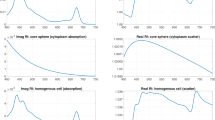Abstract
The optical scattering properties of non-spherical calcium carbonate particles were modelled using the finite difference time domain (FDTD) method. This algorithm is computationally expensive but an implementation running on a standard computer’s graphics processing unit (GPU) provided up to 40 times speed increase and made feasible several thousand model runs for particles up to size parameter 33 (4 μm for a wavelength of 376 nm in water). The model evaluates all coefficients of the single-particle Mueller matrix and, when applied to spheres in this size range, compares closely to Mie theory. The modelled unpolarised and polarised angular irradiance scattering from elongate calcium carbonate spicules displayed many differences from that of spheres of equivalent volume. Scattering features were observed that are not immediately obvious consequences of spicule geometry. The extinction efficiency of these particles is also less than that of spheres of equivalent volume. These results suggest both potential consequences of the non-sphericity of particles on instrument calibration and radiative transfer modelling, and opportunities for information extraction by polarimetry.







Similar content being viewed by others
References
Adjas A, Masse J-P, Montaggioni L (1990) Fine-grained carbonates in nearly closed reef environments: Mataiva and Takapoto atolls, Central Pacific Ocean. Sediment Geol 67:115–132
Agrawal YC, Mikkelsen OA (2009) Empirical forward scattering phase functions from 0.08 to 16 deg. for randomly shaped terrigenous 1–21 μm sediment grains. Opt Express 17:8805–8814
Agrawal YC, Pottsmith HC (2000) Instruments for particle size and settling velocity observations in sediment transport. Mar Geol 168:89–114
Agrawal YC, Whitmire A, Mikkelsen OA, Pottsmith HC (2008) Light scattering by random shaped particles and consequences on measuring suspended sediments by laser diffraction. J Geophys Res 113:C04023. doi:10.1029/2007JC004403
Bohren CF, Huffman DR (1983) Absorption and scattering of light by small particles. Wiley, Hoboken, NJ
Boss E, Pegau WS (2001) Relationship of light scattering at an angle in the backward direction to the backscattering coefficient. Appl Optics 40:5503–5507
Boss E, Slade WH, Behrenfeld M, Dall’Olmo G (2009) Acceptance angle effects on the beam attenuation in the ocean. Opt Express 17:1535–1550
Chami M, Marken E, Stamnes JJ, Khomenko G, Korotaev G (2006) Variability of the relationship between the particulate backscattering coefficient and the volume scattering function measured at fixed angles. J Geophys Res 111:C05013. doi:10.1029/2005JC003230
Dunn AK (1997) Light scattering properties of cells. PhD Thesis, University of Texas at Austin
Enríquez S, Méndez ER, Iglesias-Prieto R (2005) Multiple scattering on coral skeletons enhances light absorption by symbiotic algae. Limnol Oceanogr 50:1025–1032
Fang Q, Boas DA (2009) Monte Carlo simulation of photon migration in 3D turbid media accelerated by graphics processing units. Opt Express 22:20178–20190
Fournier GR, Forand JL (1994) Analytic phase function for ocean water. In: Jaffe JS (ed), Ocean Optics XII. Proc SPIE 2258:194–201
Furse CM, Gandhi OP (1995) Why the DFT is faster than the FFT for FDTD time-to-frequency domain conversions. IEEE Microwave Guided Wave Lett 5:326–328
Han J, Xi Y, Huang WP (2010) Acceleration of FDTD mode solver by high-performance computing techniques. Opt Express 18:13679–13692
Liu Y (1996) Fourier analysis of numerical algorithms for the Maxwell equations. J Comput Phys 124:396–416
Luebbers RJ, Schneider M (1991) A finite-difference time-domain near zone to far zone transformation. IEEE Trans Antennas Propagation 39:429–433
Mobley CD, Sundman LK, Boss E (2002) Phase function effects on oceanic light fields. Appl Optics 41:1035–1050
Mobley CD, Sundman LK, Davis CO, Bowles JH, Downes TV, Leathers RA, Montes MJ, Bisset WP, Kohler DDR, Reid RP, Louchard EM, Gleason A (2005) Interpretation of hyperspectral remote-sensing imagery by spectrum matching and look-up tables. Appl Optics 44:3576–3592
Orofino V, Blanco A, Fonti S, Marra AC, Polimeno N (2002) The complex refractive index of limestone particles: an extension to the FIR range for Mars applications. Planet Space Sci 50:839–847
Spinrad RW, Zaneveld JRV, Kitchen JC (1983) A study of the optical characteristics of the suspended particles in the benthic nepheloid layer of the Scotian shelf. J Geophys Res 88:7641–7645
Sun W, Fu Q, Chen Z (1999) Finite-difference time-domain solution of light scattering by dielectric particles with a perfectly matched layer absorbing boundary condition. Appl Optics 38:3141–3151
Taflove A, Brodwin ME (1975) Numerical solution of steady-state electromagnetic scattering problems using the time-dependent Maxwell’s equations. IEEE Trans Microwave Theory Tech 23:623–630
Taflove A, Hagness SC (2005) Computational electrodynamics: the finite-difference time-domain method, 3rd edn. Artech House, London
Veal CJ, Micheal KJ, Nunez M (2009) Partitioning of underwater direct and diffuse ultraviolet irradiance in a shallow water coral reef. Mar Freshwater Res 60:1244–1253
Veron JEN (1993) Corals of Australia and the Indo-Pacific. University of Hawaii Press, Honolulu
Yang P, Liou KN, Mischenko MI, Gao B-C (2000) Efficient finite-difference time-domain scheme for light scattering by dielectric particles: application to aerosols. Appl Optics 39:3727–3737
Yee KS (1966) Numerical solution of initial boundary value problems involving Maxwell’s equations in isotropic media. IEEE Trans Antennas Propagation 14:302–307
Acknowledgements
The author acknowledges the contribution of the editors and two anonymous reviewers whose comments assisted in improving the manuscript.
Author information
Authors and Affiliations
Corresponding author
Additional information
Responsible guest editor: M. Chami
Rights and permissions
About this article
Cite this article
Hedley, J. Modelling the optical properties of suspended particulate matter of coral reef environments using the finite difference time domain (FDTD) method. Geo-Mar Lett 32, 173–182 (2012). https://doi.org/10.1007/s00367-011-0265-8
Received:
Accepted:
Published:
Issue Date:
DOI: https://doi.org/10.1007/s00367-011-0265-8




